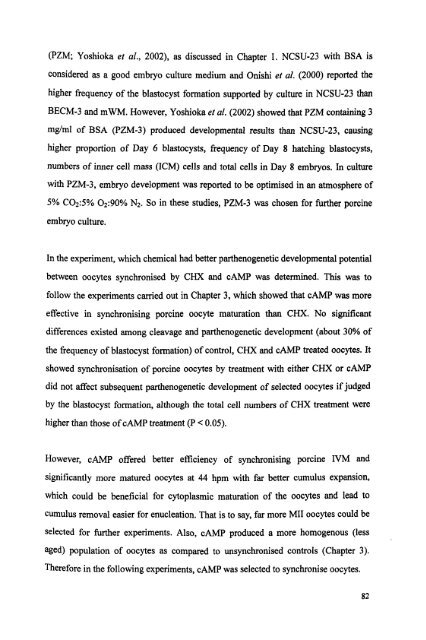-210 Nottingham - Nottingham eTheses - The University of Nottingham
-210 Nottingham - Nottingham eTheses - The University of Nottingham
-210 Nottingham - Nottingham eTheses - The University of Nottingham
Create successful ePaper yourself
Turn your PDF publications into a flip-book with our unique Google optimized e-Paper software.
(PZM; Yoshioka et al., 2002), as discussed in Chapter 1. NCSU-23 with BSA is<br />
considered as a good embryo culture medium and Onishi et al. (2000) reported the<br />
higher frequency <strong>of</strong> the blastocyst formation supported by culture in NCSU-23 than<br />
BECM-3 and mWM. However, Yoshioka et al. (2002) showed that PZM containing 3<br />
mg/ml <strong>of</strong> BSA (PZM-3) produced developmental results than NCSU-23, causing<br />
higher proportion <strong>of</strong> Day 6 blastocysts, frequency <strong>of</strong> Day 8 hatching blastocysts,<br />
numbers <strong>of</strong> inner cell mass (ICM) cells and total cells in Day 8 embryos. In culture<br />
with PZM-3, embryo development was reported to be optimised in an atmosphere <strong>of</strong><br />
5% C02: 5% 02: 90% N2. So in these studies, PZM-3 was chosen for further porcine<br />
embryo culture.<br />
In the experiment, which chemical had better parthenogenetic developmental potential<br />
between oocytes synchronised by CHX and cAMP was determined. This was to<br />
follow the experiments carried out in Chapter 3, which showed that cAMP was more<br />
effective in synchronising porcine oocyte maturation than CHX. No significant<br />
differences existed among cleavage and parthenogenetic development (about 30% <strong>of</strong><br />
the frequency <strong>of</strong> blastocyst formation) <strong>of</strong> control, CHX and cAMP treated oocytes. It<br />
showed synchronisation <strong>of</strong> porcine oocytes by treatment with either CHX or cAMP<br />
did not affect subsequent parthenogenetic development <strong>of</strong> selected oocytes if judged<br />
by the blastocyst formation, although the total cell numbers <strong>of</strong> CHX treatment were<br />
higher than those <strong>of</strong> cAMP treatment (P < 0.05).<br />
However, cAMP <strong>of</strong>fered better efficiency <strong>of</strong> synchronising porcine IVM<br />
and<br />
significantly more matured oocytes at 44 hpm with far better cumulus expansion,<br />
which could be beneficial for cytoplasmic maturation <strong>of</strong> the oocytes and lead to<br />
cumulus removal easier for enucleation. That is to say, far more MII oocytes could be<br />
selected for further experiments. Also, cAMP produced a more homogenous (less<br />
aged) population <strong>of</strong> oocytes as compared to unsynchronised controls<br />
(Chapter 3).<br />
<strong>The</strong>refore in the following experiments, CAMP was selected to synchronise oocytes.<br />
82
















